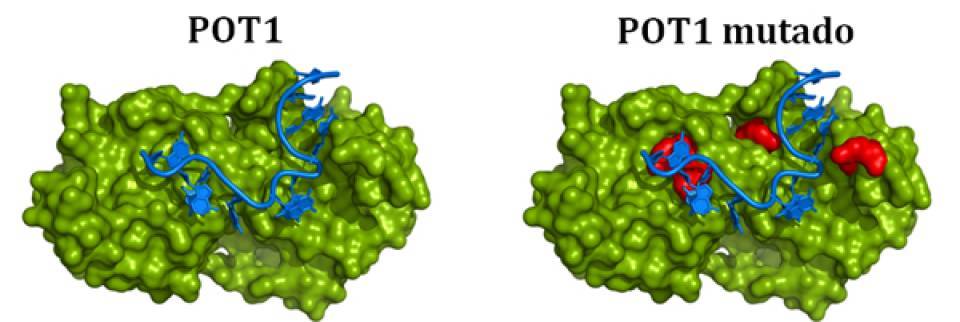"The chronic lymphatic leukemia is the most common type of leukemia in the Western countries", comments López-Otín, and adds: "Once the genetic and epigenetic changes in its development have been deciphered, it is necessary to understand the biochemical mechanisms altered by said changes, in order to improve the diagnosis and treatment of this disease".
Thus, following the previous research conducted by Campo and López-Otín and published in Nature and Nature Genetics during the past two years, the researchers focused on the mutations that affect the POT1, one of the genes involved in the protection of the edges of the chromosomes, the telomeres.
It is the first time that a gene with this function appears mutated in a human cancer. Blasco remarks: "We have been studying the biology of the telomeres for a long time, since alterations to their maintenance are associated to cancer, and to aging as well. Although some mechanisms by means of which tumorous cells alter their telomeres are known, the mutations in POT1 reveal a previously-unknown route".
Each chromosome has on its edges, in the telomeres, a protective cover formed by proteins, and POT1 is the staple that locks it into place by joining it to the telomeric DNA. All the mutations thus found on POT1 prevent this gene from carrying out its function. The DNA of the edge of the chromosome is left, this way, without its protective cover. The research of the biochemical route that leads from these anomalies to the uncontrolled growth of B cells may shed light on key aspects of the chronic lymphatic leukemia and on cancer in general.
One of the most frequently-mutated genes in leukemia
Moreover, after having analyzed the genome of 341 patients of chronic lymphatic leukemia—comparing in each case the genes of healthy cells and tumorous cells—the researchers have discovered that POT1 is one of the most frequently-mutated genes in this disease.
Previous results by the Spanish Consortium for the Study of the Genome of the Chronic Lymphatic Leukemia had already proved that thousands of mutations are involved in this disease, and that each patient presents an unique combination of hundreds of them. One of the most significant findings of the studies of the Consortium is the great genetic and molecular diversity of the disease.
The different mutated genes identify relatively small sub-groups of patients with different characteristics in their disease. In fact, the most-repeated mutations are only found in 15% of the patients. Nevertheless, its identification is a considerable breakthrough, since it is a step towards personalized treatment, based on the genetic profile of each tumor.
In the research that is now being published, the researchers found that 3.5% of the patients of chronic lymphatic leukemia present mutations in POT1, but their number escalates to 9% in the group of patients of a notably aggressive form of the disease. Thus, the study identifies POT1 as one of the most important genes for this disease.

The Spanish Consortium for the Study of the Genome of the Chronic Lymphatic Leukemia is financed by the Ministry of Economy and Competiveness through the Carlos III Health Institute, and is situated within the International Consortium for Cancer Genomes (ICGC) (www.icgc.com). Three years ago, Nature highlighted the potential relevance of the results expected from the ICGC for the development of new methods of diagnosis and therapies against cancer, since the Consortium plans to coordinate in a global scale the sequencing and the analysis of more than 500 tumorous genomes of each of the 50 most-frequent types of cancer.
Since then, Nature and Nature Genetics have published in several articles the advancements of the Spanish participants in the ICGC, based on the analysis of the genomic and epigenomic alterations of more than 100 patients of chronic lymphatic leukemia. The new research published by Nature Genetics goes deeper in one of the most outstanding discoveries derived from those early studies, and contributes to emphasize the relevance of the dynamics of the telomeres, decisive structures for a better understanding of process as complex as cancer and aging.
The Spanish contribution to the International Consortium (www.cllgenome.es) combines the work of more than a dozen of institutions, including the Clínic Hospital of Barcelona, the University of Barcelona, the University Institute of Oncology of the University of Oviedo, the Genomic Regulation Center of Barcelona, the Catalan Institute of Oncology, the Center for Cancer Research of Salamanca, the National Bank of DNA, the National Center for Oncological Research, the University of Deusto, the University of Santiago de Compostela, the Barcelona Supercomputing Center, the National Center for Genomic Analysis and the August Pi i Sunier Institute of Biomedical Research.
Reference:
Andrew J Ramsay, Víctor Quesada, Miguel Foronda, Laura Conde, Alejandra Martínez-Trillos, Neus Villamor, David Rodríguez, Agnieszka Kwarciak, Cecilia Garabaya, Mercedes Gallardo, Mónica López-Guerra, Armando López-Guillermo, Xose S Puente, María A Blasco, Elías Campo & Carlos López-Otín. POT1 mutations cause telomere dysfunction in chronic lymphocytic leukemia. Nature Genetics, 2013. doi:10.1038/ng.2584

